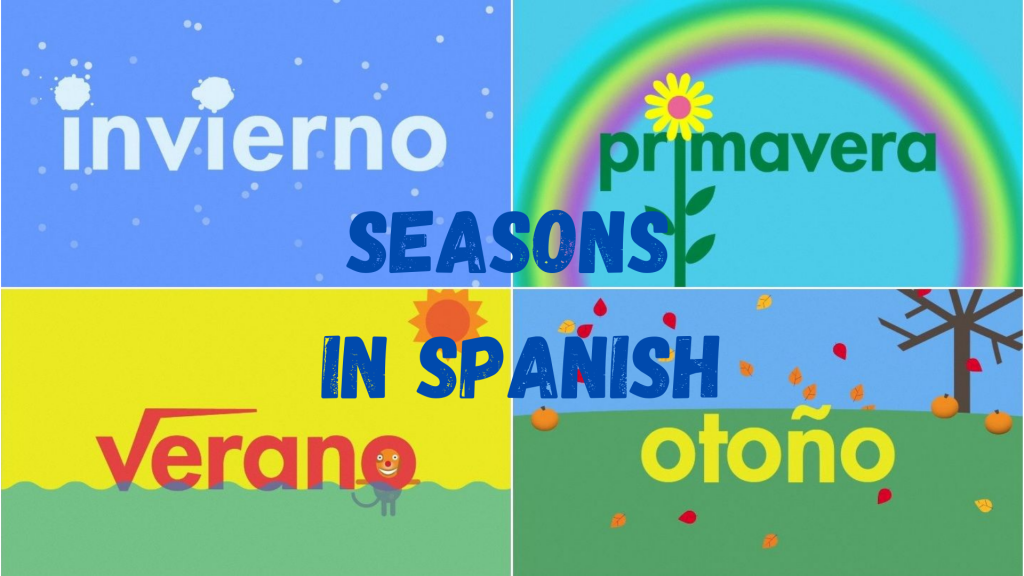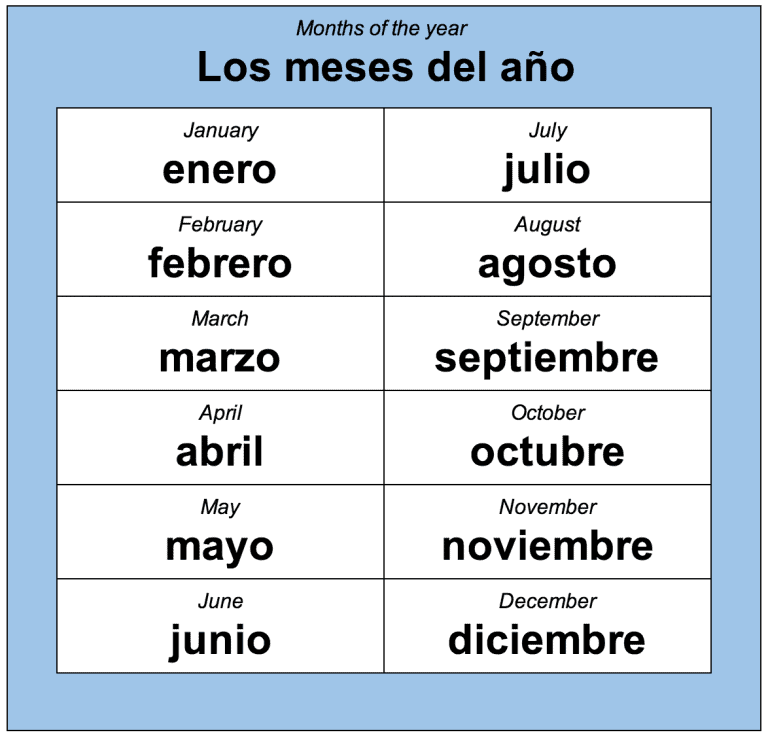Source: dzprintables
Do you know how to say all the months in Spanish?
Knowing how to express time, days of the week, as well as months of the year in Spanish, is very important because it is required for one’s day-to-day activities, for communication purposes, as well as planning and organizing one’s events. Expressing time of the day (hora del día), days of the week (días de la semana), and months of the year (meses del año), in Spanish, are straightforward words that are easy to learn with a small amount of effort. So, let’s dive into it.
Stay tuned until the end for a free PDF learning material is accessible as a downloadable link at the end of this article.
Read More:
Telling Time in Spanish: From Mañana (Morning) to Noche (Night)
Expressing Time in Spanish: Months
Months of the year in Spanish are easy to learn because they are very similar to how they are pronounced in the English language. This is due to the fact that they both emanate from Latin, dating back to the Roman Empire’s age. Month names are coined from either a god or goddess name, in honour of an event, abstract things, etc. Months in Spanish are however not capitalized like English, because they are masculine unless they are used at the beginning of a sentence or composition title. When giving particular dates in Spanish, the article el is generally used, but must come before the number rather than the month in a pattern “number + de + month + de + year.” For example, el 1 de mayo de 2020 which means 1st May 2020*.* To learn more about time, days, and months in Spanish, a free PDF learning material is accessible as a downloadable link at the end of this article.
The list of months in Spanish and their corresponding meaning in English as well as their origin is shown below.
| Spanish | English |
| enero | January |
| febrero | February |
| marzo | March |
| abril | April |
| mayo | May |
| junio | June |
| julio | July |
| agosto | August |
| septiembre | September |
| octubre | October |
| noviembre | November |
| diciembre | December |
- enero – January ( originated from the Roman god called Janus)
- febrero – February (from the feast of purification usually held at this time of the year)
- marzo – March (from Martius, the word for the planet Mars)
- abril – April (from the Greek god called Aphrodite)
- mayo – May (from the Roman earth goddess called Maia)
- junio – June (from the goddess Junio, who married to Jupiter)
- julio – July (in honor of Julius Caesar)
- agosto – August (in honor of August Caesar)
- septiembre – September (a Latin word for “seven”)
- octubre – October (from a Latin word for “eight”)
- noviembre – November (from a Latin word for “nine”)
- diciembre – December (from a Latin word for “ten”)
It is also important to note that three out of these 12 months have their adjective forms. These are abrileño (for April), marzal (for March), and agosteño (for August). Example: Las lluvias abrileñas de nuestro país son persistentes. (The April rains in our country are persistent).
Expressing Time in Spanish: Days of the Week (Los días de la Semana)
Just like our previous article on “days of the week”, it is also important to know and be able to pronounce the days of the week in Spanish. The days are like those in English because they also originate from the Roman Empire. The days got their names through the names of Roman gods and goddesses, and we still use the name to date. The days of the week in Spanish do not begin with a capital letter, and the weekend (El fin de semana) is Saturday (sábado) and Sunday (domingo), just like the English. The days of the week in Spanish are also masculine, and the article el is usually used as a prefix when writing the names, for instance, el lunes, el martes, el míercoles, el jueves, el viernes, el sábado, el domingo. However, when the days are mentioned in plural forms, such as Mondays or Fridays, only sábado and domingo have an “s” added to them. For instance, los lunes, los martes, los míercoles, los jueves, los viernes, los sábados, los domingos.
Read More:
Days of the Week in Spanish: “Lunes” (Mon) to “Domingo” (Sun)
Expressing Time in Spanish: Seasons

Seasons in Spanish are as well easy to learn, just as we have learned how to express days and months. There are four seasons of the year (estaciones del año) in Spanish just like in English. However, there are two other Spanish seasons you should be familiar with; these are the rainy season (la estación lluviosa and the dry season (la estación seca). La estación lluviosa also called invierno is characterized by almost-daily heavy rainfall and humidity, while La estación secais a period of nearly uninterrupted drought and very hot weather, sometimes called verano.
The four seasons of the year are:
- invierno — winter
- primavera — spring
- verano — summer
- otoño — autumn or fall
The names of these seasons originated from Latin. Invierno comes from hibernum, which pertains to “winter”. Primavera is coined from two words, primera which means “first” and ver, meaning “to see”, because it is the first time when the environment blossoms and becomes clear. Verano comes from veranum, which in Latin could refer to summer and lastly Otoño comes from autumnus, the root of the English “autumn”, in Northern hemisphere.
In Spanish, the names of the four seasons are normally used with definite articles and while the terms “invierno”, “verano” and “otoño” are masculine , “primavera” is a feminine noun, which is the reason why it is having a definite article la, instead of el.
As in English, seasons are thought to begin and end approximately on the year’s longest and shortest days, and the fact that all countries speaking Spanish are spread across both northern and southern hemispheres means they do not experience the same seasons at the same time. For example, in Spain and other Spanish-speaking countries in the northern hemisphere, la primavera begins around 20 march – 21 June , el verano by June 21 – September 23, el otoño by 23 September – 21 December, and el invierno begins around 21 December – 20 March. While for countries in the southern hemisphere, for example Argentina, el verano may fall around December – February, instead of June – August.
It is important to note that when the seasons are mentioned in plural forms, an “s” is added to them e.g., los veranos. The pattern “de + season” is used to write or speak about seasons in adjective form. For instance, la temporada de inviernowhich translates to “the winter season”.
Expressing Time in Spanish: Useful Phrases

Source: Bertlitz
There are various ways to tell time (el tiempo) in Spanish, depending on the situation, as well as the context of your conversation. It can be used to define a period, weather condition, particular moment, actual time, day, occasion, or even a phase in life. Now, let’s learn some useful basic communication phrases we can use in our day-to-day activities.
Vocabulary in Spanish – Vocabulary in English
- hoy dia – today
- mañana – tomorrow
- ahora – now
- ayer – yesterday
- pasado mañana – the day after tomorrow
- anteayer – the day before yesterday
- mañana – morning
- tarde – afternoon
- al mediodía – at noon
- a la medianoche – at midnight
- por la noche – in the evening or night
- la semana que viene – next week
- la semana pasada – last week
- el año que viene – next year
- el año pasado – last year
- anoche – last night
- temprano – early
- tarde – late
- en punto – exactly (Can be used to say the exact time, e.g, son las ocho en punto – it’s exactly eight o’clock)
- durante el día – during the day
Don’t Stop at Just Learning Months in Spanish!

Source: GIF Tenor
Knowing how to say some basic time-related words and phrases is very important in learning or revising a language. This is important in numerous ways which include when you want to tell your friends about a particular date, birthdays, events, occasions, schedules, in our day-to-day activities. Now that you have learned how to say time, days, months, and seasons in Spanish, you should be confident to start a conversation with your friends, family, colleagues as well as strangers. As we said, Spanish is a very easy language that is easy to learn with little effort, and you can even learn Spanish on your own in 6 steps!
The days, months, and seasons in Spanish are like how they are pronounced in English because they both originated from Latin, during the age of the Roman Empire, and the date is always written in the format “number + de + month + de + year.” Also, unlike English, the days and months are not started with a capital letter, and the article el is always used as a prefix for both months and days, however, when writing dates, the el should be written before the number.
Finally, When talking about seasons in a sentence, the format “de + season” should be followed, e.g, me encanta la temporada de invierno which means I love the winter season.
➡️ You can download a PDF file to learn more about time in Spanish here.
Do you wish to learn more Spanish words and phrases to improve your conversation, AmazingTalker can assist you to learn and speak like a native.

















